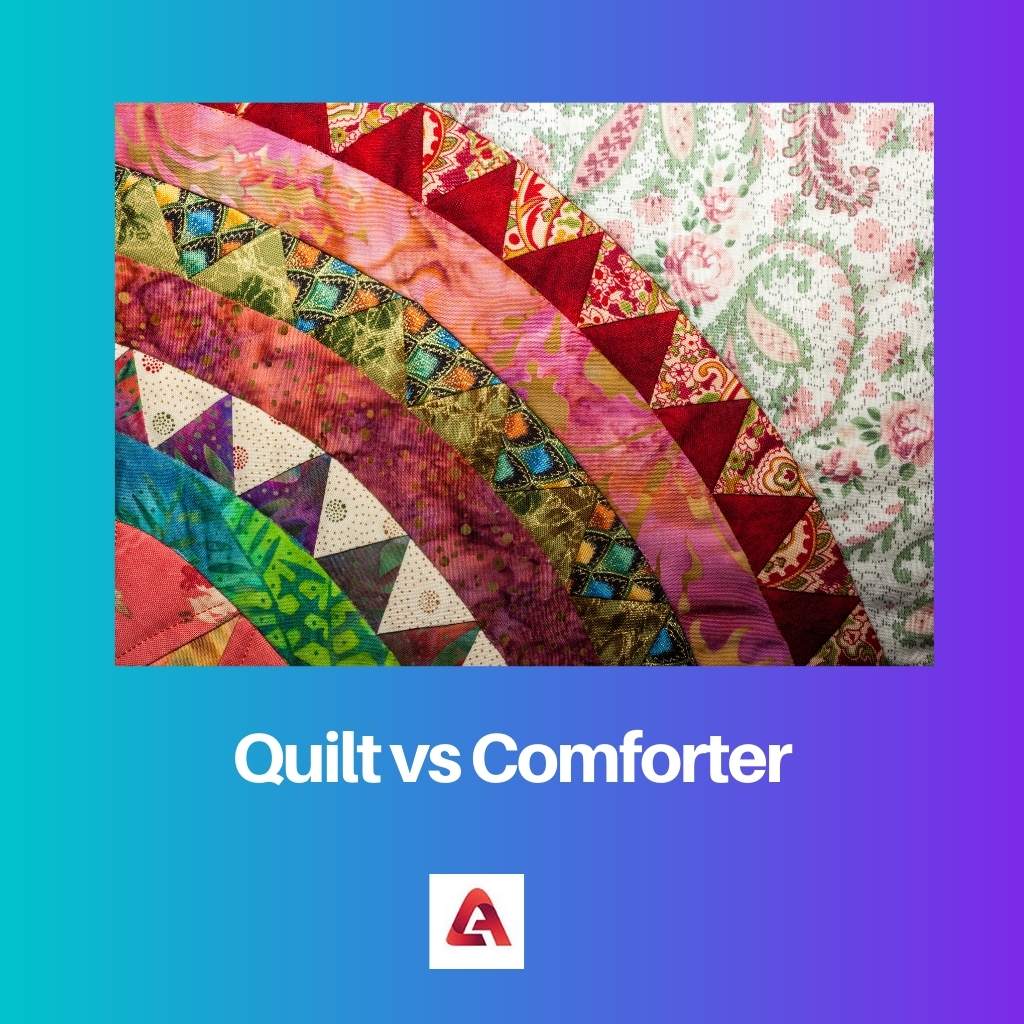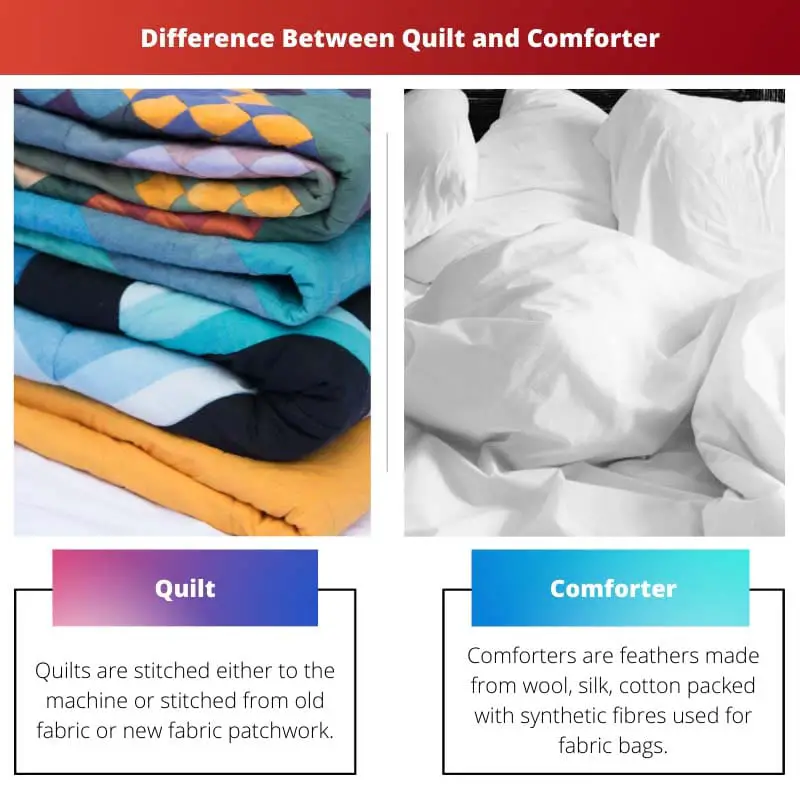Quilts and comforters are all kinds of bedding that are used somewhat differently. However, because of the geographical dialect variation, the same thing in different countries can be referred to both as a quilt and a comforter.
Quilts are rectangular textiles with a painted front and undecorated back with an isolation layer between them. The consoles, not decorated, are larger, and both faces are mostly the same.
While quilts are used for various purposes, they are used only as bed coverings. There are even couches that are much heavier than comforters. The word ‘Comforter’ is an American English term only.
In English, quilts, comforters, duvets, and comforters are called ‘doonas,’ while in Australian English, they are called ‘quilts.’
Key Takeaways
- A quilt is a type of bedding made by stitching together multiple layers of fabric, while a Comforter is a thick, fluffy blanket filled with down or synthetic fibers.
- A quilt is made by hand or using a sewing machine, while a Comforter is manufactured on an industrial scale.
- Quilt provides a more traditional and rustic feel to a bed, while a Comforter provides a more luxurious and cosy feel.
Quilt vs Comforter
Multiple fabrics are stitched together to make a quilt. A sewing machine can be used to make a quilt. It can also be made by hand. A quilt can be used in cold weather. Quilts are light in weight. Synthetic fibres are used in the making of comforters. A comforter can be designed in any shape or color. Comforters are not costly.

A quilt is a multi-layered textile, made up of two or three fabric layers. Used are 3 layers. Those layers include a woven tissue top, a batting or wadding layer, and a woven reverse together with quilting techniques.
This is how the three layers are sewn or combined to strengthen the material. Stitching patterns may be an aspect of decoration.
The comforter fabric is a style of linings constructed from two lengths of fabric or coating that are sewn together and filled with insulative warm fabrics, filled with wool or cotton padding, silk or polyester, and other down substitute fibres or a continental quilt (or only quilt), is also known as a donna in Australian English or a continental quilt or duvet.
Comparison Table
| Parameters of Comparison | Quilt | Comforter |
|---|---|---|
| Materials | Quilts are stitched either to the machine or stitched from old fabric or new fabric patchwork. | Comforters are feathers made from wool, silk, cotton packed with synthetic fibres used for fabric bags. |
| Style | The quilts lend your space a traditional brush. Quilts with patchwork designs are made in various types. | The comforters are designed in various designs based on fabrics, shapes and colours. The design of the comforters can vary. |
| Use | On cold nights, people are using several quilts. | Comforters are gently filled to change the temperature of the body per season, although quilts do not adjust to the body temperature. |
| Weight | Quilts are lightweight. | Comforters are heavy. |
| Cost | Expensive. | Not so expensive. |
What is Quilt?
For several uses, quilts can be used. They still exist on beds, but a patchwork quilt’s distinctive presence makes it a form of art. Some quilts have elaborate photos of a single big picture, a series of squares on the front that says a story, like a bible quilt from Harriet Powers.
In addition to their original intent, they were used to do everything from educating people to documenting history and commemorating major events to help with fundraising and campaigning.
For the top of a quilt, but in many instances, the top of a single piece of fabric is made of smaller pieces of fabric bound together or patchwork. These pieces are designed with pattern and color.
Quilts could provide important contextual knowledge about their authors “through the physical visualization of some sections of history.
It may be mounted on beds but also on walls used as throwing robes, as tablecloths, for tent side use, and presented on public occasions. They are used as walls. Sheets are used only as bed covers. The front and back sides appear to be much flakier than the quilts, with more isolations or covering.

What is Comforter?
Comforter is spread over a top bed sheet, like a quilt (and sometimes also blankets). Duvets are another kind of quilt, which is packed with feathers, but mostly made with synthetic fibres or substitutes since the end of the 20th century.
For safety and extended use, comfort is sometimes protected. In principle, comforts are identical to pillowcases, which are closed with zip-pads or buttons.
The comforter is surrounded by several different terminologies. The comforters are designed in various designs based on fabrics, shapes, and colors. The design of the comforters can vary.
Comforters are gently filled to change the temperature of the body per season, although quilts do not adjust to the body temperature.
The term comforter is only found in American English, as are the comforters themselves. Although not commonly used abroad, the same can be named ‘donna’ in Australia.
British English names them in the United Kingdom “eiderdowns,” “duvets,” or “continental quilts.” But most labels are more used for couches than comforters.

Main Differences Between Quilt and Comforter
- The quilts lend your space a traditional brush. Quilts with patchwork designs are made in various types, whereas comforters are designed in various designs based on fabrics, shapes, and colors. The design of the comforters can vary.
- The quilts are expensive, whereas comforters are less expensive.
- The quilts are heavy, whereas the comforters are light.
- Quilts are small in dimensions, whereas comforters are big and fluffy in dimensions.
- Quilts are stitched to the machine or stitched from a piece of old fabric or new fabric patchwork, whereas comforters are feathers made from wool, silk, and cotton packed with synthetic fibres used for fabric bags.

- https://jamanetwork.com/journals/jamapediatrics/article-abstract/1746117
- https://www.ncbi.nlm.nih.gov/pmc/articles/PMC3903787/




The comparison table provided in the article is particularly helpful in understanding the key differences between quilts and comforters. It’s interesting to note how the materials, style, and use of these bedding items vary.
Yes, the article definitely provides a comprehensive overview of quilts and comforters. I appreciate the inclusion of the comparison table for a quick reference.
I found the explanation of the uses of quilts and comforters to be very informative. It’s intriguing to learn about the diverse functions of quilts beyond traditional bedding.
The article provided a clear and concise explanation of the differences between quilts and comforters, as well as their uses. Quilts are multifunctional and rich in history, while comforters are more focused on providing warmth and comfort.
That’s an interesting point about the history and multifunctional uses of quilts. I found the article to be very informative.
Agreed, the detailed comparison between quilts and comforters was enlightening. It’s fascinating how the terminology varies in different countries.
The comprehensive comparison between quilts and comforters, along with the in-depth explanation of their construction and uses, contributes to a profound understanding of these bedding items. The insightful details regarding the historical evolution of quilts added depth to the content.
The historical context provided in the article was particularly intriguing. It adds another layer of appreciation for the cultural significance of quilts.
I appreciate the detailed analysis of the technical differences and historical background of quilts and comforters. The article offers valuable insights into the multifaceted nature of these bedding items.
The article offers a comprehensive overview of quilts and comforters, providing detailed insights into their construction, uses, and historical background. The juxtaposition of quilts as functional art and comforters as sources of warmth was particularly interesting.
The article’s emphasis on the historical context and uses of quilts and comforters provided a comprehensive understanding of these bedding items. The detailed comparison table was illuminating.
I agree, the article effectively elucidates the multifaceted nature of quilts and comforters, shedding light on their cultural and functional aspects. The section on the historical significance was especially captivating.
The article presents a thorough examination of quilts and comforters, encompassing their construction, historical context, and cultural variations. The wealth of information provided contributes to a nuanced understanding of the distinct characteristics and uses of these bedding items.
The comprehensive analysis of quilts and comforters, along with their historical significance, made for an engaging and informative read. The nuanced details provided valuable insights.
I found the comparison table to be particularly helpful in visualizing the differences between quilts and comforters. The detailed descriptions added clarity to the content.
The article serves as an educational resource on the nuanced differences between quilts and comforters, highlighting their historical and functional dimensions. The section detailing the various uses of quilts and comforters was particularly insightful.
The comparison table provided a clear visual representation of the distinctions between quilts and comforters, reinforcing the comprehensive analysis presented in the article.
The article’s thorough examination of quilts and comforters, along with the elaboration of their historical significance, was informative and engaging. The detailed comparison added depth to the content.
The comparison between quilts and comforters, along with the explanation of their construction and uses, was presented in a well-organized manner. The distinction in weight, cost, and design was particularly insightful.
The detailed comparison of quilts and comforters was enlightening. It’s interesting to see the nuanced differences in materials, design, and cost associated with these bedding items.
Absolutely, the article delves into the technical aspects of quilts and comforters, providing a comprehensive understanding of their characteristics. The emphasis on the weight and cost differentiation is valuable.
The article’s in-depth examination of quilts and comforters, accompanied by historical insights, greatly contributed to an enriched understanding of the cultural and functional aspects of these bedding items. The portrayal of quilts as artistic expressions was particularly compelling.
I found the historical analysis of quilts and comforters to be enlightening. The article effectively elucidates the diverse functions and cultural significance of these bedding items.
The extensive information provided about the construction and uses of quilts and comforters contributes to a thorough comprehension of these bedding items. The section on the historical significance of quilts was particularly engaging.
I found the article to be highly educational, especially in detailing the historical and cultural aspects of quilts. It’s intriguing to understand the diverse functions and symbolism associated with quilts.
The article effectively distinguishes between quilts and comforters, shedding light on the historical context and the cultural variations in the terminology associated with these bedding items. The detailed comparison table adds value to the content.
The section on the historical significance of quilts was particularly fascinating. It’s intriguing to learn about the various purposes and cultural implications of quilts in different contexts.
I agree, the article offers a comprehensive analysis of quilts and comforters, encompassing their materials, styles, and uses. It’s a well-researched and informative piece.